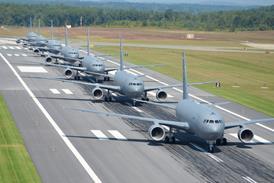PAUL LEWIS / WASHINGTON DC & BRIAN DUNN / MONTREAL
US airlines have resorted to slashing fares and extending generous incentives in an effort to kick-start air travel, as the first tangible impact of the 11 September terrorist attacks is reflected in the September traffic figures. The result has been a slight pick-up in activity, but airlines warn further cuts may be needed.
Traffic across the US airline industry plunged by an average of more than 30% in the last month as a result of a three-day country-wide grounding and a subsequent sharp drop in travel following 11 September. Airline moves to drastically cut capacity have not kept pace, averaging around 18%, with load factors plummeting.
Southwest Airlines is alone so far in not having cut services or capacity, but has suffered the biggest fall in loads from over 66% for 1-10 September to as low as 45% after the resumption of flying on 14 September. Other carriers, including Alaska and United Airlines, are moving to make further cuts before year-end.
Financial analysts Merrill Lynch forecasts an overall industry-wide $6.5 billion loss for the year, almost three times its pre-attack projection, and a $3.5 billion loss in 2002. While travel in the first week of October has shown signs of a slight recovery, analyst Michael Linenberg warns: "An offensive move by US military forces would likely forestall a return to more normal traffic levels."
In a move to stimulate traffic, airlines have been cutting fares, with Continental Airlines and United reducing business class tickets by up to 50%. American is discounting economy class domestic prices by a similar margin. Other incentives have included offering double mileage points for frequent flyer members ahead of the traditionally busy US Thanksgiving holiday.
The challenge for other airlines is to get business travellers back on scheduled flights. "We think near-term passenger levels are likely to be adversely impacted by the spread of video conferencing and increased corporate jet usage," says Merrill Lynch.
| US CARRIERS SEPT TRAFFIC FIGURES | |||
| Load Factor % | ASM change % | RPM Change % | |
| Air Tran | 55.1 | -10.5 | -28.6 |
| Alaska | 60.7 | -16.1 | -18.7 |
| America West | 59.8 | -15.3 | -21.0 |
| American | 59.6 | -22.3 | -33.7 |
| Continental | 61.0 | -18.6 | -31.0 |
| Delta | 56.2 | -17.6 | -32.4 |
| Northwest | 63.8 | -16.9 | -31.0 |
| Southwest | 53.4 | -3.6 | -21.6 |
| TWA | 50.0 | -35.9 | -54.5 |
| United | 61.0 | -21.7 | -30.7 |
| US Airways | 56.1 | 20.6 | -33.4 |
| RPM Revenue Passenger Miles | |||
| ASM Available Seat Miles | |||
Meanwhile Midway Airlines, which has not operated any flights since 11 September, is considering restarting operations if it can qualify for some of the $15 billion federal bail out package for US carriers.
Canadian airlines are getting a C$160 million ($102 million) bailout from the government to compensate for the shutdown of North American airspace on 11 September. There will be a second round of aid after the government verifies financial claims made by domestic carriers. Air Canada will get C$100 million of the money.
Transport minister David Collenette is not willing to offer Air Canada a long-term rescue package until the airline deals with its own employees and creditors. But he will consider lifting the 15% limit one individual can own of the airline and the maximum 25% foreign ownership limit.
Air Canada chief executive Robert Milton had originally requested up to C$4 billion in financial aid.
Correction Due to a compilation error, the table of US airline orders featured in the Analysis on page 39 of last week's Flight International (2-8 October) incorrectly attributed 10 Boeing orders to JetBlue Airways. The orders should have been listed under Midway Airlines, which was omitted from the list.
Source: Flight International























